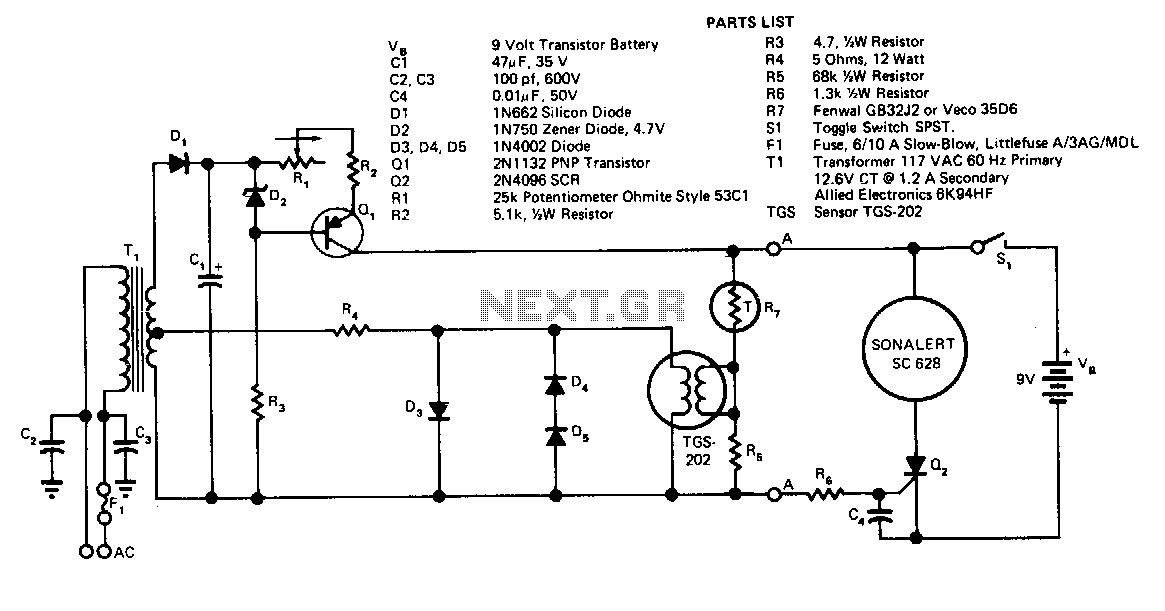
Live line Detector

Detects the presence of a live mains conductor. Minimum parts counting. If the unit is brought close to a live conductor (insulated, and even buried in plaster) capacitive coupling between the live conductor and the probe clocks the counter, and causes the LED to flash 5 times per second, because the 4017 IC divides the mains 50Hz frequency by 10. More: * Sensitivity can be varied using a more or less long sensing probe. * Due to 3V operation, the LED's current limiting resistor can be omitted. When remote from a live line, the unit stops counting, the LED resulting permanently off.
The circuit described operates as a capacitive proximity sensor for detecting live mains conductors, utilizing minimal components to achieve its functionality. The core of the circuit is based on a CD4017 decade counter IC, which is designed to count pulses and has a built-in frequency division capability.
When the sensing probe approaches a live conductor, capacitive coupling occurs between the probe and the live wire. This coupling generates a small AC voltage that is detected by the circuit. The input stage of the circuit is designed to be sensitive enough to detect this small voltage, which is then used to trigger the CD4017 counter. The counter is configured to divide the mains frequency (typically 50Hz) by 10, resulting in an output pulse rate of 5Hz. This output is used to drive an LED, which flashes at a rate of five times per second to indicate the presence of the live conductor.
The sensitivity of the circuit can be adjusted by changing the length of the sensing probe. A longer probe will increase the capacitive coupling effect, making the circuit more sensitive to the presence of live conductors. Conversely, a shorter probe will decrease sensitivity.
The circuit operates at a low voltage of 3V. Due to this low voltage operation, it is possible to omit the current limiting resistor typically used with LEDs. This simplification reduces the number of components required and makes the circuit more compact.
In the absence of a nearby live conductor, the capacitive coupling effect diminishes, and the CD4017 stops counting. Consequently, the LED remains off, indicating that no live conductor is detected. This behavior enhances the circuit's efficiency, as it conserves power when not in use. The overall design is suitable for various applications where detecting the presence of live mains conductors is necessary, particularly in environments where safety and minimal component count are priorities.Detects the presence of a live mains conductor. Minimum parts counting. If the unit is brought close to a live conductor (insulated, and even buried in plaster) capacitive coupling between the live conductor and the probe clocks the counter, and causes the LED to flash 5 times per second, because the 4017 IC divides the mains 50Hz frequency by 10. * Sensitivity can be varied using a more or less long sensing probe. * Due to 3V operation, the LED`s current limiting resistor can be omitted. When remote from a live line, the unit stops counting, the LED resulting permanently off. 🔗 External reference
The circuit described operates as a capacitive proximity sensor for detecting live mains conductors, utilizing minimal components to achieve its functionality. The core of the circuit is based on a CD4017 decade counter IC, which is designed to count pulses and has a built-in frequency division capability.
When the sensing probe approaches a live conductor, capacitive coupling occurs between the probe and the live wire. This coupling generates a small AC voltage that is detected by the circuit. The input stage of the circuit is designed to be sensitive enough to detect this small voltage, which is then used to trigger the CD4017 counter. The counter is configured to divide the mains frequency (typically 50Hz) by 10, resulting in an output pulse rate of 5Hz. This output is used to drive an LED, which flashes at a rate of five times per second to indicate the presence of the live conductor.
The sensitivity of the circuit can be adjusted by changing the length of the sensing probe. A longer probe will increase the capacitive coupling effect, making the circuit more sensitive to the presence of live conductors. Conversely, a shorter probe will decrease sensitivity.
The circuit operates at a low voltage of 3V. Due to this low voltage operation, it is possible to omit the current limiting resistor typically used with LEDs. This simplification reduces the number of components required and makes the circuit more compact.
In the absence of a nearby live conductor, the capacitive coupling effect diminishes, and the CD4017 stops counting. Consequently, the LED remains off, indicating that no live conductor is detected. This behavior enhances the circuit's efficiency, as it conserves power when not in use. The overall design is suitable for various applications where detecting the presence of live mains conductors is necessary, particularly in environments where safety and minimal component count are priorities.Detects the presence of a live mains conductor. Minimum parts counting. If the unit is brought close to a live conductor (insulated, and even buried in plaster) capacitive coupling between the live conductor and the probe clocks the counter, and causes the LED to flash 5 times per second, because the 4017 IC divides the mains 50Hz frequency by 10. * Sensitivity can be varied using a more or less long sensing probe. * Due to 3V operation, the LED`s current limiting resistor can be omitted. When remote from a live line, the unit stops counting, the LED resulting permanently off. 🔗 External reference





